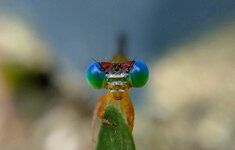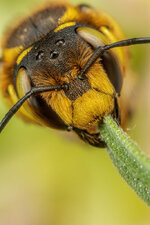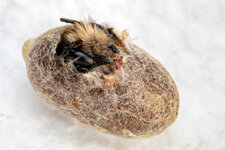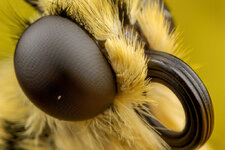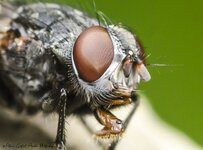Closed Theme Eyes photo theme
- Thread starter MinitecaPhotographie
- Start date
You are using an out of date browser. It may not display this or other websites correctly.
You should upgrade or use an alternative browser.
You should upgrade or use an alternative browser.
Welcome to our Community
Wanting to join the rest of our members? Feel free to sign up today.
Join now!
The Photo Theme is closed for entries and commenting.
- Status
- Not open for further replies.
Beautiful eyes||I'm Watching You ||View attachment 13799
I took this photo in 2018 with Xiaomi Mi A1 with clip on lens attached.
Technique: I found this European Wool carder (Anthidium manicatum) bee snoozing on a Lavender stalk before sunset and woke up early the next morning to photograph it before it warmed up and got active. I placed an artificial flower in the background to keep the background from being black. This is a single, uncropped, frame taken hand held. I'm holding on to the Lavender with my left hand, and bracing the lens on that same hand so both camera and critter are on the same "platform". Once I got the focus point where I wanted it I twisted my wrist to push the area of acceptable focus deeper into the frame. The end result is a "magic angle" that makes it seem like there's more depth of field than there really is.
Tech Specs: Canon 80D (F11, 1/250, ISO 200 with highlight tone priority) + a Canon MP-E 65mm macro lens (set to over 2x) + a diffused MT-24EX (both flash heads on the Canon flash mount, E-TTL metering with -1 2/3 FEC).
Note: Those three orbs at the top of its head are Simple Eyes (ocelli), and are possibly used to help the critter to be more stable in the air. But my theory is that they may assist in predator avoidance. Since they are arranged in a triangle it might be possible to triangulate the speed and direction of an attack as a shadow falls over those simple eyes.
View attachment 15543Snoozing European Wool Carder Bee by John Kimbler, on Flickr
This is an emerging male Red Mason Bee (Osmia bicornis) chewing his way out of a cocoon.
Tech Specs: Canon 80D (F11, 1/200, ISO 200 due to Highlight Tone Priority) + a Canon MP-E 65mm macro lens (set to about 2.5x) + a diffused MT-26EX-RT, E-TTL metering, -1/3 FEC, second curtain sync). This is a single, uncropped, frame taken hand held.
View attachment 15544Emerging Red Mason Bee by John Kimbler, on Flickr
I bought a kit last year so I could raise a few Swallowtail Butterflies (Papilio machaon) and this is a frame with the Canon MP-E 65mm macro lens set to just under 5x.
Tech Specs: Canon 80D (F11, 1/250, ISO 100) + a Canon MP-E 65mm macro lens (set to almost 5x) + a diffused MT-26EX-RT with a Kaiser adjustable flash shoe on the "A" head (the key), E-TTL metering, -1/3 FEC). This is a single, uncropped, frame taken hand held. In post I used Sharpen AI and Clarity in that order.
View attachment 15545Swallowtail Portrait by John Kimbler, on Flickr
Tech Specs: Canon 80D (F11, 1/250, ISO 200 with highlight tone priority) + a Canon MP-E 65mm macro lens (set to over 2x) + a diffused MT-24EX (both flash heads on the Canon flash mount, E-TTL metering with -1 2/3 FEC).
Note: Those three orbs at the top of its head are Simple Eyes (ocelli), and are possibly used to help the critter to be more stable in the air. But my theory is that they may assist in predator avoidance. Since they are arranged in a triangle it might be possible to triangulate the speed and direction of an attack as a shadow falls over those simple eyes.
View attachment 15543Snoozing European Wool Carder Bee by John Kimbler, on Flickr
This is an emerging male Red Mason Bee (Osmia bicornis) chewing his way out of a cocoon.
Tech Specs: Canon 80D (F11, 1/200, ISO 200 due to Highlight Tone Priority) + a Canon MP-E 65mm macro lens (set to about 2.5x) + a diffused MT-26EX-RT, E-TTL metering, -1/3 FEC, second curtain sync). This is a single, uncropped, frame taken hand held.
View attachment 15544Emerging Red Mason Bee by John Kimbler, on Flickr
I bought a kit last year so I could raise a few Swallowtail Butterflies (Papilio machaon) and this is a frame with the Canon MP-E 65mm macro lens set to just under 5x.
Tech Specs: Canon 80D (F11, 1/250, ISO 100) + a Canon MP-E 65mm macro lens (set to almost 5x) + a diffused MT-26EX-RT with a Kaiser adjustable flash shoe on the "A" head (the key), E-TTL metering, -1/3 FEC). This is a single, uncropped, frame taken hand held. In post I used Sharpen AI and Clarity in that order.
View attachment 15545Swallowtail Portrait by John Kimbler, on Flickr
Attachments
Marvellous images. I would love to know how you manage to achieve such a beautiful images.Technique: I found this European Wool carder (Anthidium manicatum) bee snoozing on a Lavender stalk before sunset and woke up early the next morning to photograph it before it warmed up and got active. I placed an artificial flower in the background to keep the background from being black. This is a single, uncropped, frame taken hand held. I'm holding on to the Lavender with my left hand, and bracing the lens on that same hand so both camera and critter are on the same "platform". Once I got the focus point where I wanted it I twisted my wrist to push the area of acceptable focus deeper into the frame. The end result is a "magic angle" that makes it seem like there's more depth of field than there really is.
Tech Specs: Canon 80D (F11, 1/250, ISO 200 with highlight tone priority) + a Canon MP-E 65mm macro lens (set to over 2x) + a diffused MT-24EX (both flash heads on the Canon flash mount, E-TTL metering with -1 2/3 FEC).
Note: Those three orbs at the top of its head are Simple Eyes (ocelli), and are possibly used to help the critter to be more stable in the air. But my theory is that they may assist in predator avoidance. Since they are arranged in a triangle it might be possible to triangulate the speed and direction of an attack as a shadow falls over those simple eyes.
View attachment 15543Snoozing European Wool Carder Bee by John Kimbler, on Flickr
This is an emerging male Red Mason Bee (Osmia bicornis) chewing his way out of a cocoon.
Tech Specs: Canon 80D (F11, 1/200, ISO 200 due to Highlight Tone Priority) + a Canon MP-E 65mm macro lens (set to about 2.5x) + a diffused MT-26EX-RT, E-TTL metering, -1/3 FEC, second curtain sync). This is a single, uncropped, frame taken hand held.
View attachment 15544Emerging Red Mason Bee by John Kimbler, on Flickr
I bought a kit last year so I could raise a few Swallowtail Butterflies (Papilio machaon) and this is a frame with the Canon MP-E 65mm macro lens set to just under 5x.
Tech Specs: Canon 80D (F11, 1/250, ISO 100) + a Canon MP-E 65mm macro lens (set to almost 5x) + a diffused MT-26EX-RT with a Kaiser adjustable flash shoe on the "A" head (the key), E-TTL metering, -1/3 FEC). This is a single, uncropped, frame taken hand held. In post I used Sharpen AI and Clarity in that order.
View attachment 15545Swallowtail Portrait by John Kimbler, on Flickr
Technique: I found this European Wool carder (Anthidium manicatum) bee snoozing on a Lavender stalk before sunset and woke up early the next morning to photograph it before it warmed up and got active. I placed an artificial flower in the background to keep the background from being black. This is a single, uncropped, frame taken hand held. I'm holding on to the Lavender with my left hand, and bracing the lens on that same hand so both camera and critter are on the same "platform". Once I got the focus point where I wanted it I twisted my wrist to push the area of acceptable focus deeper into the frame. The end result is a "magic angle" that makes it seem like there's more depth of field than there really is.
Tech Specs: Canon 80D (F11, 1/250, ISO 200 with highlight tone priority) + a Canon MP-E 65mm macro lens (set to over 2x) + a diffused MT-24EX (both flash heads on the Canon flash mount, E-TTL metering with -1 2/3 FEC).
Note: Those three orbs at the top of its head are Simple Eyes (ocelli), and are possibly used to help the critter to be more stable in the air. But my theory is that they may assist in predator avoidance. Since they are arranged in a triangle it might be possible to triangulate the speed and direction of an attack as a shadow falls over those simple eyes.
View attachment 15543Snoozing European Wool Carder Bee by John Kimbler, on Flickr
This is an emerging male Red Mason Bee (Osmia bicornis) chewing his way out of a cocoon.
Tech Specs: Canon 80D (F11, 1/200, ISO 200 due to Highlight Tone Priority) + a Canon MP-E 65mm macro lens (set to about 2.5x) + a diffused MT-26EX-RT, E-TTL metering, -1/3 FEC, second curtain sync). This is a single, uncropped, frame taken hand held.
View attachment 15544Emerging Red Mason Bee by John Kimbler, on Flickr
I bought a kit last year so I could raise a few Swallowtail Butterflies (Papilio machaon) and this is a frame with the Canon MP-E 65mm macro lens set to just under 5x.
Tech Specs: Canon 80D (F11, 1/250, ISO 100) + a Canon MP-E 65mm macro lens (set to almost 5x) + a diffused MT-26EX-RT with a Kaiser adjustable flash shoe on the "A" head (the key), E-TTL metering, -1/3 FEC). This is a single, uncropped, frame taken hand held. In post I used Sharpen AI and Clarity in that order.
View attachment 15545Swallowtail Portrait by John Kimbler, on Flickr
Thanks!
I have a blog where I give away all my secrets, and tutorials at Deviant Art.
Last edited by a moderator:
thanks. You can share tutorials on our forum if you'd like or have time. Unfortunately promoting own blog or social media sites are not allowed now, apart from your profile.Technique: I found this European Wool carder (Anthidium manicatum) bee snoozing on a Lavender stalk before sunset and woke up early the next morning to photograph it before it warmed up and got active. I placed an artificial flower in the background to keep the background from being black. This is a single, uncropped, frame taken hand held. I'm holding on to the Lavender with my left hand, and bracing the lens on that same hand so both camera and critter are on the same "platform". Once I got the focus point where I wanted it I twisted my wrist to push the area of acceptable focus deeper into the frame. The end result is a "magic angle" that makes it seem like there's more depth of field than there really is.
Tech Specs: Canon 80D (F11, 1/250, ISO 200 with highlight tone priority) + a Canon MP-E 65mm macro lens (set to over 2x) + a diffused MT-24EX (both flash heads on the Canon flash mount, E-TTL metering with -1 2/3 FEC).
Note: Those three orbs at the top of its head are Simple Eyes (ocelli), and are possibly used to help the critter to be more stable in the air. But my theory is that they may assist in predator avoidance. Since they are arranged in a triangle it might be possible to triangulate the speed and direction of an attack as a shadow falls over those simple eyes.
View attachment 15543Snoozing European Wool Carder Bee by John Kimbler, on Flickr
This is an emerging male Red Mason Bee (Osmia bicornis) chewing his way out of a cocoon.
Tech Specs: Canon 80D (F11, 1/200, ISO 200 due to Highlight Tone Priority) + a Canon MP-E 65mm macro lens (set to about 2.5x) + a diffused MT-26EX-RT, E-TTL metering, -1/3 FEC, second curtain sync). This is a single, uncropped, frame taken hand held.
View attachment 15544Emerging Red Mason Bee by John Kimbler, on Flickr
I bought a kit last year so I could raise a few Swallowtail Butterflies (Papilio machaon) and this is a frame with the Canon MP-E 65mm macro lens set to just under 5x.
Tech Specs: Canon 80D (F11, 1/250, ISO 100) + a Canon MP-E 65mm macro lens (set to almost 5x) + a diffused MT-26EX-RT with a Kaiser adjustable flash shoe on the "A" head (the key), E-TTL metering, -1/3 FEC). This is a single, uncropped, frame taken hand held. In post I used Sharpen AI and Clarity in that order.
View attachment 15545Swallowtail Portrait by John Kimbler, on Flickr
OK. But you asked...Technique: I found this European Wool carder (Anthidium manicatum) bee snoozing on a Lavender stalk before sunset and woke up early the next morning to photograph it before it warmed up and got active. I placed an artificial flower in the background to keep the background from being black. This is a single, uncropped, frame taken hand held. I'm holding on to the Lavender with my left hand, and bracing the lens on that same hand so both camera and critter are on the same "platform". Once I got the focus point where I wanted it I twisted my wrist to push the area of acceptable focus deeper into the frame. The end result is a "magic angle" that makes it seem like there's more depth of field than there really is.
Tech Specs: Canon 80D (F11, 1/250, ISO 200 with highlight tone priority) + a Canon MP-E 65mm macro lens (set to over 2x) + a diffused MT-24EX (both flash heads on the Canon flash mount, E-TTL metering with -1 2/3 FEC).
Note: Those three orbs at the top of its head are Simple Eyes (ocelli), and are possibly used to help the critter to be more stable in the air. But my theory is that they may assist in predator avoidance. Since they are arranged in a triangle it might be possible to triangulate the speed and direction of an attack as a shadow falls over those simple eyes.
View attachment 15543Snoozing European Wool Carder Bee by John Kimbler, on Flickr
This is an emerging male Red Mason Bee (Osmia bicornis) chewing his way out of a cocoon.
Tech Specs: Canon 80D (F11, 1/200, ISO 200 due to Highlight Tone Priority) + a Canon MP-E 65mm macro lens (set to about 2.5x) + a diffused MT-26EX-RT, E-TTL metering, -1/3 FEC, second curtain sync). This is a single, uncropped, frame taken hand held.
View attachment 15544Emerging Red Mason Bee by John Kimbler, on Flickr
I bought a kit last year so I could raise a few Swallowtail Butterflies (Papilio machaon) and this is a frame with the Canon MP-E 65mm macro lens set to just under 5x.
Tech Specs: Canon 80D (F11, 1/250, ISO 100) + a Canon MP-E 65mm macro lens (set to almost 5x) + a diffused MT-26EX-RT with a Kaiser adjustable flash shoe on the "A" head (the key), E-TTL metering, -1/3 FEC). This is a single, uncropped, frame taken hand held. In post I used Sharpen AI and Clarity in that order.
View attachment 15545Swallowtail Portrait by John Kimbler, on Flickr
- Status
- Not open for further replies.

